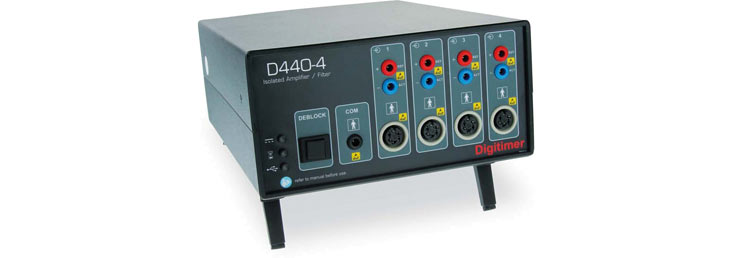
Digitimer D440
The Digitimer D440 Isolated EMG Amplifier is a low noise solution for human EMG studies, specifically those related to nerve excitability. Low noise performance is significantly enhanced through the use of a Driven Right Leg (DRL) circuit which reduces Common-mode interference.
The D440 features an amplification range of ×100 to ×20k. The gain, filter and mode settings for individual channels are adjusted using Digitimer’s “virtual front panel” software or other software via a COM interface.
The D440 is available in two versions, the D440-2 (two channels) and the D440-4 (four channels). Each channel features a pair of 1.5 mm touch proof sockets for active and reference electrode connection, but provision is also made for shielded leads with 5-pin DIN connectors. Each amplifier is supplied with a signal output cable (D440-OL-xx, D connector to multiple BNC), electrode connection cable (D-440-IL, 1.2m long with 3 × 1.5 mm DIN42802 sockets for electrode connection and 270 degree 5-pin DIN plug for amplifier connection) and USB cable for connection to the host computer.
- Portable, standalone design
- Extremely low noise
- Rapid recovery from stimulus artefacts e.g magnetic or electrical stimulation
- AC and DC operating modes
- Analogue signal output for ultimate compatibility with data acquisition systems
- Computer control through dedicated Digitimer software or external programs (via COM interface)
- Designed for human research applications, including nerve excitability testing

Features
- Two (D440-2) or Four (D440-4) Channels of amplification, filtering and isolation – with independent control of each channel.
- Primarily designed as an AC amplifier, the D440 will also operate in DC mode.
- Input impedance of each channel is 1 GΩ.
- On/off control of individual channels. The electronic inputs of individual channels can be grounded reducing cross-talk noise when recording from fewer channels. This also disconnects the patient from the electronics.
- Inputs may be electronically switched between a differential and single-ended system.
- Common ‘Driven Right Leg’ system with adjustable gain for lower noise.
- Overall system GAIN for each channel x100 (10mV/V) to ×20,000 (50 μV/V).
- Outputs have a ±5V range. The rear panel has a BNC socket for monitoring the output of channel 1 (this signal is mirrored on a 9-way 'D' connector on the rear panel along with the output signals of channels 2, 3 and 4). A signal output cable terminated with an appropriate number of BNC connections is supplied with each amplifier.
- LOW-CUT FILTER settings are selectable between 0 (DC), 0.159 Hz, 1Hz, 3Hz, 5Hz, 10Hz, 30 Hz and 50Hz for -3dB and are first order.
- HIGH-CUT FILTER settings are selectable between 1kHz, 3kHz, 5kHz, and 10kHz for -3dB and are second order, low phase shift Bessel style filters.
- The front panel contains three LEDs which are used to indicate the units power supply status, Internal-Error and Data-Bus Busy.
- The rear panel contains a mains IEC inlet socket with mains voltage selection, fuses and mains on/off switch, as well a 9-way “D” connector, for connecting channels to a data acquisition system and a USB port for connection to a Windows PC.
- A push button Deblock control is present on the front panel with a TTL compatible Deblock facility available via a BNC connector on the rear panel.
- Standalone Use - Previous amplifier settings will be maintained if a D440 is used without PC connection.
- Supplied with "virtual front panel" control software to adjust the settings of a single D440 amplifier. For applications requiring more than 4 channels, we recommend our D360 8-Channel Isolated Patient Amplifier. The D440 includes a COM interface to allow other software applications to control the amplifier settings.
- Mains operating voltage between 115V and 230V (switch selectable) at 50-60Hz. Note: for locations with low mains voltage (< 105V), such as some areas of Japan, a custom D440 with a replaced mains transformer will be required.
Note: The Digitimer D440 is NOT a medical device and use is currently limited to human research applications.
